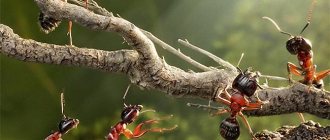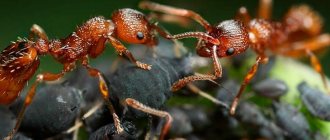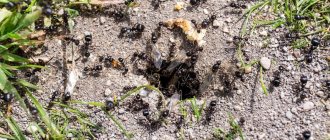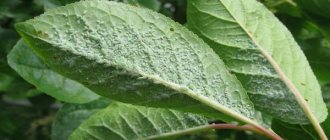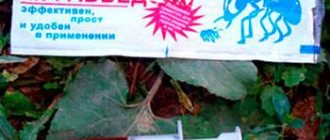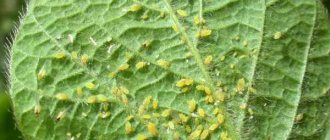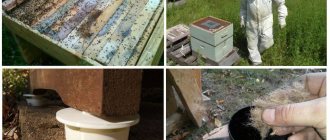There are many insects living in a garden or summer cottage. Some of them are beneficial, and some are harmful. Ants do both. They make the soil in the beds loose, so that it is better saturated with oxygen, and they also improve the composition of the soil, introducing phosphorus and potassium into it in a form suitable for plants. They also destroy a number of harmful insects. But at the same time, the ants themselves are more likely to be pests in the garden. Gardeners and summer residents fight ants every summer. It is impossible to get rid of ants in your garden beds once and for all, but you can drive them away for a while to get a rich harvest.
What harm do ants do in garden beds?
There are several types of ants in the garden. Sometimes these are red forest ants that wander in by chance in search of food if the area is near a forest. They build an anthill in the forest, and not next to a person. But more often these are black garden ants, which build their home in the garden. They feed on sweet fruits and berries, and also breed aphids, which devour juicy fresh leaves, shoots, and fruits of plants grown by humans.
It is necessary to fight against ants in the garden and in the beds, otherwise you may lose part or all of the harvest.
What harm do garden ants cause?
- grow, distribute, protect and protect aphids - one of the main pests of trees and shrubs: ants feed on the honeydew that aphids secrete, therefore they are interested in increasing the number of these pests; these two types of insects live in symbiosis, so you need to fight both garden ants and aphids at the same time;
- ants eat berries, they are very fond of, for example, strawberries, and also eat flowers and buds, preventing fruits from forming;
- eat and spoil shoots and root vegetables with a high sugar content;
- can bite a person working with the soil, and their bites are unpleasant;
- if an anthill is built on a garden bed, the soil around it becomes less fertile;
- digging passages and holes for themselves, ants gnaw the roots of plants;
- with a large number of ants in the beds, the soil becomes too acidic and becomes unsuitable for growing vegetables.
Before getting rid of garden ants, it is important to understand that these insects are both harmful and beneficial. If the colony is small, and individual ants are just coming to the beds, then they are included in the general ecosystem and are rather useful. But if they have chosen your garden as a permanent place of residence and built their anthill here, then it makes sense to start fighting them.
What harm does the insect cause?
- Ants can damage young growths of ornamental plants and flower buds that contain nectar.
- Some fruits are damaged (eg apricots).
- Some species nest in the trunks or bark of trees, which negatively affects the trees and weakens them.
- They can destroy decorative flower beds, vegetable gardens and lawns when they dig underground corridors, damaging the roots, rhizomes, and tubers of plants. Corridors and tunnels additionally dry the soil.
- Insects, protecting the anthill, become very aggressive - their bites hurt, cause erythema on the skin, and sometimes allergic reactions. When insects bite, they inject a poison containing formic acid into the body.
- Ants love the sweet taste, and leftover food left on the veranda or terrace is a real treat for them. Sometimes insects move into houses and apartments in search of food.
- Ants feed on the sweet secretions of aphids, which can cause real damage to plants. They protect aphids from natural enemies (ladybugs). Some species create their own colonies of aphids - aphid larvae are transferred deep into the anthill for the winter, and in the spring adult insects are again brought outside, where they can feed on plants and supply the ants with the dew they need.
How to get rid of ants in the garden
The beds are designed for growing a wide variety of plants. They are usually located next to each other, so ants can move between them without any problems. Even if the crop itself is not very attractive to them, they can ruin it by laying ant trails along it.
If there are ants in the garden, you need to remove them carefully, trying not to harm the plantings. You cannot water or fill the beds with chemicals. They are toxic and can destroy plants or make them dangerous to humans. To get rid of ants in garden beds, you need to use only safe products.
Active resistance: how to poison ants in the house
Passive methods of controlling insects usually have minimal effect, so in any case you will have to use active methods of destruction. If you are not confident in your abilities, seek help from professionals.
Recipe 5 – professional pest control
If, despite all your attempts, you were unable to locate the colony’s nest and all the methods you tried did not help, contact the experts. This is especially true if a colony of ants terrorizes several apartments at once. Sharing this order will cost you less, and simultaneous processing of all adjacent rooms will certainly eliminate the problem. Before the specialist arrives, you should remove all food, personal belongings and indoor plants. Think about where you can stay during the day while the poisons are in effect in your apartment. After a couple of weeks, do a wet cleaning of the entire house. The price of exterminator services, as of July 2018, starts from 2,000 rubles.
How to get rid of ants in a private home using chemicals
Manufacturers of insecticidal preparations offer a wide range of products in different forms. You can use sprays, powders, pencils, gels.
Important! Some of the drugs cannot be used if there are animals or small children in the house.
Each type of such drugs has its own disadvantages:
- Aerosols act only locally. If no nest is found, they are ineffective;
- gels cannot be used if you have a dog, cat or small child;
- crayons and powders are also very toxic and should be used with extreme caution.
How to kill ants in the house with aerosols and powders
Pesticides in aerosol containers are a fast-acting remedy. Insects caught under the aerosol stream die almost instantly. In most cases, such compositions are not dangerous to humans, but when using them, care should be taken to protect the respiratory tract.
Recipe 6 – sprays and aerosols
You will find many insecticidal aerosols on sale, here are the most popular ones.
| Name | Image | Peculiarities |
| Raptor | The drug is based on the insecticide Deltamethrin. The spray has a minty smell, which skillfully masks the specific aroma common to insecticides. | |
| Combat | The drug of Korean origin confidently fights all crawling insects. Has a lemon or mint scent. | |
| Clean house | The spray works to kill wasps, ants, cockroaches and bedbugs. One can is enough to treat 30 m². |
Recipe 7 – powders and pencils
Many housewives prefer to use powders and pencils instead of sprays. There is no odor from them, so you can use such products at any time and in any room. If you don't know how to get rid of ants in the kitchen, use crayons and powders. But we must admit that this method is less effective than aerosols. Among the most popular formulations for home use, several should be noted.
| Name | Image | Peculiarities |
| Pyrethrum | Powder from ordinary medicinal chamomile is a natural and very effective insect repellent. | |
| Delicia | This powder must be dissolved in water and applied to places where ants move and into cracks and crevices where they can hide. | |
| Muratsid | The powder is applied diluted with water. It is sprayed in places where the movement of pests is detected. The active ingredient is the insecticide Diazinon. | |
| Mashenka | The most popular and effective remedy, according to the editors of HomeMyHome.ru. Effective against bedbugs, cockroaches and ants. The manufacturing company is constantly improving the composition of the chalk. |
Effective ant repellents in the form of gels and microcapsules
We continue to study how to remove black and red ants from the house. Next in line are gel formulations.
Recipe 8 – spot application gel
The gels are applied in small drops along baseboards and along the edges of shelves and cabinets where ants are found. You will not notice the effect immediately - after 10-15 days, but there is a high chance of destroying the heart of the colony - the uterus. Working individuals carry the gel into the anthill, attracted by its smell.
| Means | Image | Peculiarities |
| Globall | The German drug has amazing effectiveness: one drop kills up to 500 insects. The original product has a holographic sticker. | |
| Clean house | A highly toxic product that must be used very carefully. The colony will die within a couple of days after applying the composition. | |
| a great warrior | Works against household and garden insects. It begins to act on the first day. Applied precisely. | |
| Triple Strike | A product based on cypermethrin works on the first day. A new application is required after 21 days. | |
| Chops | An inexpensive gel designed for treating apartments. One tube is enough for 40 m². | |
| Brownie | It works for a very long time - 3 months. It has no pungent odor and is effective against all types of house ants. | |
| Raptor | A highly effective drug that goes well with the aerosol of the same name. Works during the week. |
Recipe 9 – concentrate
Microcapsules have a prolonged action. Just one capsule of the drug is enough to protect 100 m² of living space. One of the most famous drugs of this effect is “Get”.
Moving an anthill
Methods for getting rid of ants can be very controversial and sometimes very complicated. For example, if you find an anthill on your property, you can put it in a plastic bag, removing the entire above-ground part and the underground part - to the depth of a spade bayonet or even deeper. In the bag, the anthill is transferred to the forest away from human habitation and dumped there in a suitable place. The insects themselves will restore it. This is a fairly humane method, but labor-intensive and dangerous - the anthill can be large and heavy, and the ants bite very painfully.
The second way is, on the contrary, to bring an anthill with red ants from the forest to the site and leave it next to the home of the black ants. Two types of insects are at war. The forest ones will destroy the blacks, and they themselves will return to the forest. But the method, of course, is dubious, long and labor-intensive.
Preventive measures
It is easier to prevent uninvited guests from appearing than to try to get them out. So try to follow simple rules:
- regularly carry out wet cleaning, including using active substances that can repel insects;
- Pack food carefully and do not store it in places accessible to ants;
- make sure that there are no unsealed cracks in the walls and floors;
- remove dog and cat food after animals eat;
- Treat all areas where ants may enter with chalk or gel.
How to scare ants away from garden beds
Ants are very sensitive to odors. They are attracted to sweet smells, but they cannot stand aromatic herbs, for example, oregano, parsley, dill, mint, mustard, tobacco, valerian. These plants can be planted in beds - between rows of crops or along the perimeter. They will protect the plantings from ants. Also, insects do not like the smell of tomato tops, garlic, and celandine. Marigolds are also unpleasant for them, so you can repel ants beautifully by planting these flowers between the beds.
In addition to plants, these insects do not like the smell of coal and ash. These substances, in turn, act as fertilizer, so you can scatter ash or burnt coals over the beds. This will repel insects and enrich the soil.
Starch repels garden ants. They avoid it and never eat it. Therefore, you can spread potato peelings between rows of plants or around the beds. Of course, it doesn't look very nice, but it can protect against ant invasion. You can also water the beds with a not very concentrated solution of mustard powder or garlic infusion (a few crushed cloves of garlic per liter of water, leave for a day). This is safe for garden crops, but unpleasant for ants.
The smell of kerosene is very unpleasant for pests. Of course, you shouldn’t water the beds with it, but you can treat the outside of the wooden formwork, if any, as well as the wooden bridges between the beds. They do not use pure kerosene, but diluted in water: 10 tablespoons per 10 liters of water. Instead of pouring, you can use rags soaked in kerosene: it can be placed between the rows of plants. Kerosene can be replaced with other strong-smelling substances: turpentine, vinegar.
Another odorous remedy is ammonia. In small concentrations it is safe for plants, but unpleasant for insects. You can add it to water for irrigation in a ratio of 1:100.
All aromatic methods of fighting ants in garden beds work much worse than in a house or greenhouse, because odors dissipate very quickly in the open air.
Types of ants
House ants and forest ants are two different types of insects that differ in size, feeding methods and habitat. The red species living in the forest are hard workers who build large anthills and destroy forest pests; they have a size of 4-9 mm. Domestic aliens are very small, barely growing to 3 mm, which can settle anywhere in the house, but have nothing to do with their forest brothers.
On a note!
These 2 types of ants also differ in character: forest dwellers, defending their nest, may well bite a person or an animal that disturbs their peace, but domestic ones do not bite at all.
Black ants or garden ants are pests that cause a lot of trouble for gardeners. They settle on some plant along with aphids, which they use for their food. After some time, the plant affected by aphids dies. Therefore, all gardeners and gardeners will have to protect their plantings from such pests so as not to lose their harvest. Knowing which plants garden ants don’t like, this is within everyone’s power.
Types of ants
Lures and traps
If there are few ants, you can destroy them by preparing traps and bait. As mentioned above, these insects love sweets. In places where ants accumulate, you can place sticky traps from which these pests will not be able to escape. Traps can be made from jam and honey, which need to be placed in bottles or jars. The ants will get inside, but will not be able to get back out. Also, sticky tape can act as a trap, which will trap aphids and ants if you wrap it around the trunks of bushes and trees. Another remedy is vegetable oil. If an ant gets into it, it will not be able to cleanse itself. Vegetable oil can be used to water paths or beds between plantings, but this method may not be the most pleasant for gardeners.
How to fight ants in the house using passive industrial means
The beginning of a pest control company is a deep cleaning of the entire house. It is important to remove all insect food sources, wipe down all possible habitats with disinfectants, and seal any cracks with caulk or sealant. If you have already managed to find the nest at this stage, simply fill it with boiling water.
If it was not possible to immediately detect the location of the uterus, use factory-made disinsection products:
Mechanical ant traps and barriers
A mechanical trap or barrier can be an excellent preventive measure. Scout ants that fall for the bait will not lead the colony with them.
Recipe 1 – sticky tapes
Sticky tape with a powerful adhesive base and attractive bait for insects can destroy a significant part of the colony. Place it on the migration routes of workers.
Recipe 2 – electric trap
Destroys insects using a weak discharge of electricity. This method is effective not only against small ants, but also against cockroaches and various beetles. Keep in mind that such devices kill only worker insects; the queen in the anthill will produce new offspring to replace them, so there will be practically no result.
Recipe 3 – poison traps
Such traps contain bait poisoned with an insecticide. The worker ants do not die immediately; they carry the poison into the anthill.
Related article:
How to get rid of midges in the kitchen using home remedies and household chemicals; Are midges dangerous and where do they come from in the kitchen? means of prevention against the appearance of insects in cereals, vegetables and sewage - read the publication.
How to drive ants out of your home using ultrasound
Pest control using ultrasonic devices is a relatively new method that is only gaining popularity. If you are puzzled by the question of how to remove ants from your home, pay attention to this know-how. Such devices are still quite expensive and do not always give the expected results.
Recipe 4 – ultrasonic repeller
The operating life of the device is three months. Repellers vary in range and power source: they can be powered by mains or batteries. Typically, such devices act not only against ants, but also against cockroaches, bedbugs and flies.
Destruction of anthills using folk remedies
There are control methods that are undesirable to use in or near garden beds. They will harm not only insects, but also plantings, but if there is no other option to remove ants, then you have to use them. Garden ants do not build an anthill in the form known to everyone, but an underground nest. The entrance to this nest looks like a hole in the ground.
If it is located in a garden bed, you will have to destroy the nest. How can I do that:
- prepare a solution from 100 g of vegetable oil, a liter of boiling water, 5 tablespoons of granulated sugar and 30 g of boric acid, mix thoroughly and pour into the nest, covering the entrance with polyethylene; for greater effect, you can add 200 ml of vinegar to the solution;
- add 2 tablespoons of ammonia to five liters of water and also pour the solution into the nest;
- Mix vegetable oil with boiling water in equal proportions, add ground black pepper, camphor or bay leaf and also pour into the nest.
All these methods are safe for garden beds, but harmful to insects. You may have to repeat filling the anthill several times every 2 to 3 days. You can fill the anthill with quicklime and fill it with water, but in the case of an underground nest, this remedy may not destroy it entirely, but only from above. In addition, lime damages the roots of plants, so you need to use it (as well as pouring boiling water) very carefully near cultivated plants.
Indoor Pest Control
Essential oils that repel insects What ants are afraid of in the house are the same plants as in nature.
Often, instead of the flowers themselves, their essential oils are used. Apartment pests are afraid of the grass wormwood, tansy, chamomile, mint, lemon balm, and lavender. Spices, garlic cloves, and coffee are actively used. Essential oils are dripped onto the night light bulb and left on. When the light bulb heats up, a smell will begin to spread throughout the room. Oils are added to water for washing floors and wiping furniture. The baseboards should be washed thoroughly. Prepare a solution and pour it into ant nests.
The following oils are particularly effective:
- lemon;
- rosemary;
- lavender;
- tangerine;
- conifers;
- cinnamon;
- mint;
- anise;
- black pepper.
Choose any oil whose smell does not irritate a person and use it in any suggested way. The protection lasts as long as the aroma is present. Odors should be changed periodically to prevent insects from adapting. Mint drops have a beneficial effect on a person’s well-being, but they can repel insects in a matter of days.
Why is it difficult to get rid of garden ants?
Black ants live in the garden in huge colonies, including several thousand adult individuals. Their nest can go a couple of meters into the ground; inside it has a complex layout with a large number of passages, holes, and storage rooms. Deep inside is the queen ant. She is busy reproducing the population. She constantly lays eggs and does nothing else. She is fed, served, and protected by other ants. The entire life of an ant colony is centered around the queen. If you destroy her, then the remaining ants in rare cases can “appoint” a new queen. But much more often the colony disintegrates and the insects leave the anthill. This means that to successfully control ants, you need to kill their queen. But this is difficult to do, since it is securely and deeply hidden.
To destroy the queen, the nest must be completely destroyed. If the nest is built in a bed where plants are already growing, this part of the harvest will have to be sacrificed. You need to completely dig up the place where the anthill is located, fill it with boiling water, hot oil, and other solutions listed just above. To be sure, the procedure must be repeated after a few days. It is advisable to remove all this soil along with the ants outside the site. Of course, after such treatment, the bed for growing plants will have to be formed anew.
If there are a lot of ants crawling in the garden and vegetable garden, but you have not been able to find a nest, getting rid of these pests will not be so easy.
Content
- TOP 20 “folk remedies” for ants
- 1. Medicinal chamomile
- 2. Sweet trap
- 3. Baits with boric acid
- 4. Yeast from ants
- 5. Garlic
- 6. Essential oils (mint, eucalyptus, citrus, etc.)
- 7. Anise seeds, laurel and valerian extracts
- 8. Glue traps
- 9. Red pepper, mustard powder
- 10. Moving the anthill
- 11. Boiling water (boiling water)
- 12. Growing plants that repel ants
- 13. Fight against aphids
- 14. Smoked meats
- 15. Semolina and other cereals
- 16. Tobacco and shag dust
- 17. Kerosene, diesel fuel, carbolic acid against ants
- 18. Water obstacles
- 19. Salt
- 20. Lime from ants
- As recommendations
Every gardener and gardener has in his or her arsenal proven “folk remedies” for fighting ants and other insect pests. This unique knowledge is passed down from generation to generation, remaining relevant to this day.
| READ MORE: “How to get rid of ants on your property - THREE main methods” |
Traditional methods of killing ants
You can use the same ant repellents in your garden as you would in your home or greenhouse. But it’s worth considering that being outdoors has its own challenges. Firstly, beneficial insects may also suffer from these products. Secondly, children or pets can eat hazardous substances on the street. Thirdly, having a large amount of available food in the beds, ants can simply ignore the baits. But it's still worth a try. This will help reduce the number of pests.
Baits with different active ingredients are used against garden ants.
Boric acid
The most famous poisonous bait is balls of minced meat, bread crumb, chopped boiled egg, mashed boiled potatoes and other products with the addition of a small amount of boric acid. Boric acid is also mixed in sugar syrup and jam. Liquid treats are placed along the path of the ants in flat saucers or lids; the balls are simply laid out next to the beds and where ants are most often seen. Boric acid, entering the body of an ant, kills it. But it is important not to exceed the concentration, otherwise the death of insects will occur instantly. And for the successful extermination of the livestock, it is necessary that the working ants have time to bring the bait with poison to the anthill and feed it to the insects that do not leave the nest and the queen.
Borax affects ants in the same way as boric acid. It can be used in the same way.
Baking soda
Baking soda is harmful to these pests. Once in the body of an ant, it reacts with the acid secreted by these insects. The resulting substance paralyzes the nervous system and kills pests. Ants avoid pure soda and do not eat it. But you can mix it with sugar and flour and scatter this mixture in heaps on the beds. It is safe for plants, but will help reduce the number of insects in the garden
Yeast
If you add a little yeast to foods attractive to ants - flour, sugar, minced meat, boiled eggs or potatoes - they will swell in the stomach of the insects and simply tear them apart.
Millet
Ants cannot digest millet, but they eat it anyway. The millet remains in the insect's body, clogs it and ultimately kills it. Millet can be sprinkled on ant trails in small piles. But it is worth remembering that this can attract birds, which will eat not only it, but also ants, as well as berries.
Attention: all edible baits with poison must be renewed regularly, as they can dry out, be washed away by rain or blown away by strong winds.
Popular Home Methods
There are a lot of folk remedies for garden ants in the garden, and it is not at all necessary to go to the store for them. Almost every home has at least one of them. Let's consider only the most accessible and proven ones:
- Given the love of insects for sweets, you need to place bait for garden ants on the site: several jars of jam, honey, or just sugar water. Ants will climb there to eat, and the owner will only need to periodically rinse the jars with boiling water, killing the arthropods.
- Regular baking soda is as effective against ants as poison. All anthills found on the site are thickly sprinkled with it. Insects will quickly leave the now unsuitable housing.
- You can speed up the procedure if you mix baking soda and powdered sugar in equal proportions and also sprinkle on the anthill. Six-legged sweet tooths will pounce on such a delicacy, not suspecting that it is fatal to them.
- Soda against garden pests can also be used in solution. Pour two tbsp into a one and a half liter plastic bottle. l. soda, add water and mix well by shaking. The solution is poured onto the anthill, sprinkled with dry soil and covered with polyethylene to block the access of oxygen inside.
- Another very simple but effective way to remove garden ants using folk methods is to water the anthill to the very bottom with boiling water, warm lime, or livestock urine.
- It is known that some products, for example, semolina, corn flour, and millet also help against ants. Insects not only eat them themselves, but also carry them to the nursery to feed their fellows. Once in the stomach, the grains swell, and insects that are unable to digest them die. Depending on the size, semolina or millet from 2 to 3 kg is poured onto the anthill.
- As in the case of soda, to speed up the process, cereals, flour or semolina from pests are mixed with sugar. For one serving of sugar, take 3-4 servings of other products.
- Yeast has the same effect. A small amount of yeast is diluted in warm water with the addition of honey, jam or just sugar. Saucers with the drug can be placed near the anthill.
- Ammonia is also used very often against garden pests. It is especially convenient when you need to eliminate the entire anthill. Before removing the ant “capital”, the place where it is located needs to be dug deep. During the digging process, add ammonia diluted in water to the ground at the rate of 1 part alcohol per 100 parts water, as well as ash or lime. This solution will seem like fertilizer to the trees, and the ants will die or leave.
- Almost all strong pungent odors help get rid of garden ants for a long time: the smell of smoked fish, the stench of herring, the aroma of fragrant vegetable oil, freshly ground cinnamon. Arthropods cannot tolerate these aromas so much that as soon as they smell them, they leave their old homes and never return to them.
- Sheepskin treated with carbolic acid will also help to expel ants from their place. At a height of about 20 centimeters from the ground, the garden tree is wrapped in wide strips of chopped fur, with the wool facing out. The strong smell of carbolic acid will deter pests.
- In old pre-revolutionary newspapers, they often published extremely simple advice on how to remove garden ants using folk tricks. It was recommended to mix soot with ash, cover the ground with insects with this layer, then pour it all generously with a strong solution of salt water. It was believed that ants in these areas of the garden could be forgotten for several years.
It is better to carry out actions with an anthill in the evening, when all the insects have returned to their home.
How to use insecticides in the garden
Gels are most effective against ants. For example, you can take “Medilis-Anti-Ant” or “Medilis-Anti-Cockroach”. They have similar effects. To fight ants in the beds, you can squeeze out the gel in a dotted line onto the boards and place them between the rows of plants. The products remain effective for three months. After the rains they need to be renewed. Such gel-like insecticides do not contain a very large amount of active substance, that is, when dissolved with water - rain or used for irrigation - their concentration in the ground will not be critical.
It is not recommended to use chemicals in the form of granules or powders to control insects in beds when plants are planted and growing on them. They take not only nutrients from the soil, but also toxic ones. If the concentration of poisons is exceeded, root vegetables, berries, and leafy greens can be dangerous. Therefore, before using insecticides, you should always read the instructions and strictly follow the manufacturer’s recommendations.
If ants annoyed you in your garden beds in summer, they will overwinter well in their underground nest and will also feel at ease in the garden next season. To prevent this from happening, after harvesting it is necessary to carefully dig up all the beds. If an anthill is found in them, it must be destroyed: pour it with an insecticide solution, for example, “Medilis-Ziper” or “Medilis-Super”. The same insecticides can be used during the season, before harvesting, when the plants are sitting in the beds, but you should not spill the solution on the ground next to the plants, but spray the beds around the perimeter and the paths between them. If there are currant bushes next to the beds, you definitely need to treat the distance between them: it is on currants that there are always the most aphids and ants. In addition to the beds, you need to examine the entire area. An anthill can be located anywhere. It is necessary to remove debris, fallen leaves, sawed or broken branches, pieces of roofing felt, boards - under them there may be an entrance to the nest.
In the spring, before planting begins, when the beds are prepared, they are dug up and carefully inspected. You can use insecticides when digging, but after using them it is advisable that at least 20 days pass before planting.
Any insecticide against ants must be used in strict accordance with the instructions. Usually the manufacturer writes recommendations on the concentration and use of the products; a measuring cup is included with the bottle, so using such drugs is easy and safe.
About the advantages of repelling methods
Ants living in homes cause significant damage to health, as they crawl everywhere, carry infections, and get into food. These seemingly innocent insects can come from anywhere, for example, from the street on shoes or with garden soil from the garden. In any case, they cause discomfort, and it will take a lot of time to remove them.
Their small size and their ability to live in entire colonies allow ants to stay in hard-to-reach places. There are several methods that you can use to ensure that they leave the premises forever.
Several repellent methods and their advantages:
- Ultrasonic devices. Modern devices run on batteries or electricity. Their main advantage is coverage of an area with a radius of up to 100 m. High-frequency ultrasound radiation protects against insects of all types: flies, cockroaches and mosquitoes.
- Traditional methods. For repelling, environmentally friendly products are used that do not affect the health of people and animals.
- Keeping the house clean. Cleanliness in your living space is a means of preventing unexpected guests from appearing. It is recommended to clean regularly and not leave food and water in visible places.
- Use of chemicals. Modern chemicals are effective, and many owners prefer their use.
Positive results can be obtained by repelling insects using one of these methods, the main thing is to do everything correctly.
Prevention of ants
You can prevent the occurrence of anthills on your garden plot by carrying out gardening activities, including:
- timely digging of the earth;
- if you remove old tree bark;
- placing plant residues in a compost heap during harvesting;
- refusal to plant linden and viburnum in the garden;
- sowing mint, garlic, onions and calendula around the perimeter of the site;
- ridding the land of weeds.
Mint on the site as prevention against ants
At home, you can prevent ants from appearing in the following ways:
- remove food from the table;
- do not leave dirty dishes;
- collect crumbs;
- get rid of stains;
- store garbage in a sealed bag;
- clean the house regularly.
In garden plots, in most cases, ants are not completely exterminated, only the necessary plantings are treated. The only exception is the situation when ants fall into the well. But if they enter domestic living spaces, they can harm both the property and the health of the owners of the house or apartment. In this case, fighting them is mandatory.
How to remove ants from flower pots
How to remove ants from flower pots
There is a list of removal methods if ants appear on flowers and how to fight them:
- The widely used well-known folk method of flooding is carried out by placing a flower pot in a large, deep container, which must be filled with water. If your household equipment does not have a container of a suitable size, the pot is filled to the top with water. After a few minutes, when faced with flooding conditions, the pests will almost stop fussing;
- Work on replacing the soil must be carried out correctly: the pot is turned over and the flower is carefully removed from it. Next, the entire root system is thoroughly cleaned and washed to remove eggs laid by ants;
- The method of applying repellents is to treat the pot and trunk with garlic or vegetable oil.
- The list of herbs that repel ants includes:
- sagebrush;
- mint;
- lavender;
- anise;
- parsley;
- tomato tops;
- basil;
- cinnamon;
- carnation;
- black pepper;
- red pepper.
Herbs for ants
Insects cannot tolerate the smell of the above herbs, which forces them to look for a new habitat.
Helpful advice. If it is impossible to replace the contaminated soil, it must be calcined by placing it in a preheated oven for 20 minutes. The soil can be used for its intended purpose after cooling.
- You can also catch ants by covering a flower pot with tape so that the sticky side faces outward;
- A soap solution for killing ants is prepared from 1 teaspoon of liquid soap dissolved in 0.5 liters of water. The resulting liquid is poured into a spray bottle and used to treat the flower planting by spraying. In addition, it is recommended to pour a little solution into the soil;
- You can exterminate ants by placing a mixture of oatmeal and honey near the container with the flower. Honey is a strong-smelling component that attracts ants, oatmeal is a poisonous substance for these insects, and if they eat it, they will immediately die;
- When ant pockets appear in a flower pot, you can sprinkle the soil with millet. When eating cereal, the ants will die, since due to the swelling of the millet inside the insect, its body is deformed;
Why do ants live in flowers?
Ants appear in indoor flowers for the following reasons:
- irregular cleaning: a full trash can, leftover food on the table and floor - these are the things that attract the attention of pests;
- ants or their eggs can be brought into the house on clothes or shoes from the street;
- due to the fact that these pests are heat-loving insects, with the arrival of cold weather they rush into human housing; the ideal conditions for their stay are in the absence of hygiene;
- insects may come from a neighboring apartment, the owners of which have decided to get rid of pests.
Ants in a flower pot Once in an apartment, ants will definitely take a liking to a flower pot and settle in it. After all, it is in it that favorable conditions are created for pests to live.
Is it possible to drive ants away from a site without causing them harm?
To maintain ecological balance, even pests must be treated humanely. There are ways to repel insects or block their path.
If there are several anthills at your dacha, they can be moved to another place, away from the site. Ants build their nests in warm and sunny areas. If you move an ant heap into the shade, the anthill will quickly become empty. Ants cannot tolerate the smell of valerian, parsley, bay leaf, mustard and tomato. Summer residents lay out leaves and branches of plants near ant nests, passages or trees. You can put twigs, parts around or plant marigolds, mint, cloves, onions, and garlic.
Gardeners use millet and semolina as bait. The principle of action is that the cereal swells in the stomach and the insect dies.
